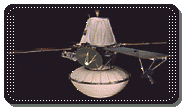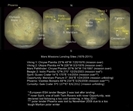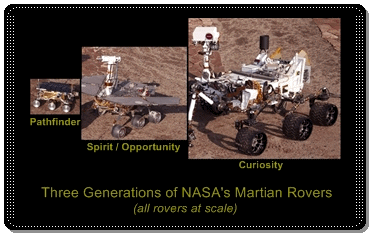
Only about 40 percent of the missions ever sent to Mars -- by any space agency -- have been successful. The U.S. is the only nation whose missions have survived a Mars landing. Only seven successful missions to the surface of Mars have taken place in the history of spaceflight. As soon as the early 1960s Mars was chosen as a target to numerous former USSR missions. All of them failed. First Martian success came on July, 14th 1965 when the U.S. craft Mariner 4 successfully performed a Mars flyby, returning 21 photos. The first detailed study of the engineering challenges of an actual trip to the Red Planet was published by Wernher von Braun in his 1952 book, 'The Mars Project.' Von Braun began writing the manuscript in 1947 while working for the U.S. Army at Fort Bliss, in El Paso, Texas. At the time, he was helping launch rockets at the nearby White Sands Proving Ground in New Mexico. In his book, von Braun suggested that a mission to Mars would require a fleet of spacecraft, noting that when Christopher Columbus sailed from Spain in 1492, it was with three ships. A series of episodes of Walt Disney’s popular show, Disneyland then helped the general public gain their first view of the possibility of human space travel through television between 1955 and 1957, with 'science factuals.' In November 1962, NASA approved the Mariner Mars 1964 Project to send two spacecraft to fly by Mars and take photographs and make other measurements during the encounter. The JPL in Pasadena, California, managed the project, building on its experience with the Mariner 2 encounter with Venus in December 1962. Each spacecraft weighed 575 pounds and carried seven science instruments: the television imaging system enabled topographic reconnaissance of the Martian surface, the Helium Magnetometer measured magnetic field strength around the planet, the Ionization Chamber and particle flux detector measured the omnidirectional flux of particle radiation near Mars and in interplanetary space, the Cosmic Dust Detector measured dust particle momentum and mass distribution, the Cosmic Ray Telescope measured charged particles, the Trapped Radiation Detector consisted of three Geiger-Muller detectors to measure any charged particles that may be trapped by a Martian magnetic field, and the Solar Plasma Probe measured the density, velocity, temperature, and direction of movement of protons streaming from the Sun. During the flyby of Mars, the spacecraft recorded the images onboard for playback to Earth after the encounter. The first of the two spacecraft, Mariner 3, failed after launch in November 1964 due its fairing not separating during the ascent, and it eventually sailed on into a solar orbit. Mariner 4 then successfully launched on Nov. 28, just two days before the close of the launch window. Had the spacecraft remained on its initial trajectory it would have missed Mars by about 155,000 miles, but a course correction on Dec. 5 reduced the flyby distance. On July 14, 1965, after a 228-day cruise from Earth, Mariner 4 passed within 6,118 miles of Mars, snapping 21 photographs of the planet and taking scientific measurements. The Mariner 4 was one of the great successes of the early U.S. space program and it took the first photographs ever of another planet from space. The spacecraft passed behind the planet as seen from Earth, allowing a radio occultation study to estimate the density of the Martian atmosphere. Playback of the flyby imagery began soon after Mariner 4 emerged from behind Mars and continued until Aug. 3. The data Mariner 4 beamed back to Earth surprised many scientists: a very low surface atmospheric pressure was measured, a surface temperature of -100° C, no magnetic field, a heavily cratered surface resembling the Moon, although the photographs covered less than 1 % of the Martian surface and did not represent Mars as we know it today. It was approximately 40 minutes prior to closest approach on July 15, 1965, at a range of 6,118 miles (9800km), that the television camera began taking the first of 21 black and white photographs. All in all, these findings dashed many scientists’ expectations of Mars as a place hospitable to life
Exploration of Mars, since Mariner 4’s arrival in 1965 and following missions, generally, also dissipated science fiction writers' fanciful stories about encounters with Martians. Shortly after that pioneering encounter of Mariner 4, NASA authorized the 'Mariner Mars 1969 project,' consisting of two identical spacecraft to make closer fly-bys of the Red Planet and take more detailed photographs and other measurements. Each spacecraft carried eight experiments: a infrared spectrometer; a infrared radiometer to measure the surface temperature of Mars; a ultraviolet spectrometer; a S-band occultation experiment; a thermal control flux monitor; a television camera system with wide- and narrow-angle telescopes; a celestial mechanics experiment; and a general relativity experiment. Mariner 6 and 7 were NASA’s next steps in the exploration of Mars at the time of the Apollo program. Mariner 6 was saved from doom as a helium pressure leak with its Atlas launch rocket could be halted. Mariner 6 eventually launched on Feb. 25, 1969 and Mariner 7, on top of a new Atlas-Centaur, followed on Mar. 27. Their respective Centaur upper stages sent them on their way to Mars as course corrections on Mar. 1 for Mariner 6, and Apr. 8 for Mariner 7 refined their trajectories. Because of their different paths, the two spacecraft arrived at Mars just five days apart despite the month separating their launches. During the encounter, the Mariner 6 returned 75 photographs and science data. Contact had been temporarily lost with Mariner 7 just five days before its planned encounter at Mars, but by Aug. 2 the spacecraft was restored to full capability, passing three days later within 2,130 miles of Mars’ southern hemisphere, and returning 126 photographs and science data. Earth-based telescopes in the 1960s could not reveal Martian surface features smaller than 62 miles (100km). The Mariner 4 photographs in 1965 had shown details as small as about two miles as the total area imaged however covered less than 1 percent of the planet's surface. Mariner 6 and 7 as far as they are concerned took a sequence of far-encounter images that covered the entire planet at resolutions far greater than possible with Earth-based telescopes. The near-encounter close-up images covered about 20 percent of the planet's surface, with resolution down to 900 feet using the narrow-angle camera. The Mariner 7 managed to capture an image of Mars' larger moon Phobos as it passed below the spacecraft, close to the camera's resolving power, representing the first photograph of a planetary satellite taken by a spacecraft. During its encounter, Mariner 6 returned a total of 75 photographs, 50 during the far encounter phase and 25 during the near encounter. Mariner 7 added 93 far-encounter and 33 near-encounter photos. The infrared radiometers on both spacecraft indicated that the thin Martian atmosphere was composed almost entirely of carbon dioxide, as was the south polar cap. Mariner 9 after that, turned the first Martian orbiter from November 1971 to October 1972. The Mariner 9 had been designed to continue the atmospheric studies begun by the Mariners 6 and 7, and he mapped more than 70 percent of the Martian surface. Viking 1 turned the first human-made object to successfully soft-land on the Red Planet
 | Viking 1 and 2 cruise configuration |
Viking missions were USA next step to Mars. Originally planned for 1973 they could leave in 1975 only due to the complexity of the mission. They had as an objective to obtain high resolution images of the Martian surface, characterize the structure and composition of the atmosphere and surface, and conduct on-the-spot biological tests for life on another planet. Both missions, Viking 1 and 2, were composed of an orbiter and of a lander. Interestingly both missions relied on the orbiter to choose their lander's landing site: mission's first month was dedicated to Mars observation from orbit, and to find an appropriate landing site. Both Vikings were heavy payloads ever attempted, as to accomplish these heavy launches, NASA decided to pair the Centaur upper stage with the Titan III launch vehicle. Viking 1 launched on August, 20th 1975 and reached Mars orbit on June, 19th 1976. Viking 2 launched on September, 9th 1975 and reached Mars on August, 7th 1976. The Vikings had been named for the fearless Nordic explorers of Earth. They constituted two nearly identical spacecraft. Plans originally called for the Viking 1 lander to touch down on July 4, 1976, America’s bicentennial. First pictures taken from the orbit were alarming as the site appeared to be unsafe and the Viking 2 was speeding to a orbit at Mars next August 7! That was a threat of a orbital jam which the technique then could not handle. So the decision was taken to delay the Viking 1. The Vikings were both launched through a Titan Centaur rocket. Once the landing phase reached, landers separated from their orbiters and parachuted in Mars' atmosphere, jettisonning their heat shield. At an altitude of about 5,000 ft (1.5 km) above the surface, landers -unfolded legs- separated from their parachute and used three retro-engines ("descent propulsion system") to control descent and land safely on Martian ground. Viking landing occurred at a speed of 2 mps (7 mph). Viking 1 lander touched down on July, 20th 1976 -- upon touchdown, Viking 1 took its first picture of the dusty and rocky surface and relayed that historic image to Earth -- as Viking 2 landed on September, 3rd. Viking 1 was at Chryse Planitia western slope. Viking 2 at Utopia Planitia. Both craft performed an analysis of soil in search for life. No clear evidence was found and scientists concluded that Mars was self-sterilizing. Sun ultraviolet radiation, soil extreme dryness, and soil chemistry oxidizing mechanisms are preventing living organisms apparition in Martian soil. Unexpected and enigmatic chemical activity was found however as landers provided data about Martian soil, atmosphere and weather patterns too
->More About the Vikings Life Results!
When the Vikings had analyzed the Martian soil, they just found two chlorine compounds, chloromethane and
dichloromethane, which were attributed then to contamination by onboard fluids, as both compound broke down nutrients they had added with Martian soil. The polar Martian Phoenix lander lately detected a chlorine-based chemical called perchlorate, leading to assume that elements found by the Vikings were leftovers of when perchlorate would have destroyed original soil organics. The question further however is that soil organics can have biological or nonbiological origins as organic compounds found on asteroids, comets or in the Kuiper Belt are not necessarily linked to any form of life, like the case on Earth. They are just considered life's building blocks instead. Next NASA Mars Laboratory will use a new method in detecting life at Mars, with a heating mode and a liquid extraction mode, as that latter mode likely will reveal organics. Other views lately were that a very reactive nonorganic substance had imitated the activity of life in the Vikings experiments and hydrogen peroxide and ozone (O3) those compounds and due to the strong electric fields generated inside the vast Martian dust storms. Such fields could be breaking apart carbon dioxide and water molecules in the atmosphere, which recombine and fall unto the Martian soil. In one of the Viking experiments, known as Labeled Release (LR), they scooped up soil samples and applied a nutrient cocktail. If microbes were present in the soil, they would likely metabolize the nutrient and release carbon dioxide or methane. The experiment did indicate metabolism, but the other two Viking experiments did not find any organic molecules in the soil. The science team believed the LR data had been skewed by a non-biological property of Martian soil, as that remains the consensus view
| Viking Lander 1 and 2 panoramas (from left to right: Viking 1 camera 2, Viking 2 cameras 1 and 2). pictures courtesy NASA/NSSDC |
Meanwhile Viking orbiters kept on their mission from orbit, studying Mars and its atmosphere, and acting as a radio relay for landers. They brought about 50,000 orbital pictures and a produced a Mars comprehensive view. Orbiters continued their work well beyond their planned duration. Viking 1 orbiter emitted until August, 7th 1980 as Viking 2 until July, 25th 1978. As far as they were concerned, both landers, due to their radioisotope power generators rendering them independent of any available sunlight, worked until November, 11th 1982 (Viking 1) and April, 11th 1980 (Viking 2). Many Viking innovations are still being used today for robotic Mars exploration. Landing the Vikings required a precisely choreographed ballet of heat shields, parachutes and rockets. It was the Vikings, on a other hand, that touched off an explosion in the field of extreme-environment biology that eventually demonstrated how life can exist in some unlikely environments at Earth like deep-sea hydrothermal vents, Antarctic sandstone, or volcanic caves. The Vikings also captured imaginations of scientists, engineers and the public about Mars. The Viking team was a 750-person one made up of NASA, industry, and university engineers, scientists and technicians
USA did not return Mars until 1997, with Mars Global Surveyor, an orbiter. Mars Global Surveyor stopped working in 2006. It has been preceded by an orbiter unsuccessful attempt in 1992. Mission Mars Pathfinder landed a mini-rover on Mars in 1997 -the little Sojourner- as Mars Odyssey successfully entered in a Martian orbit in 2001 as it is still working now, of which with its THEMIS (Thermal Emission Imaging System) infrared camera. MAVEN (Mars Atmosphere and Volatile Evolution) launched in 2013 as it is designed to study the behavior of the upper atmosphere and the loss of gas to space. It is still working at Mars. Meanwhile two more missions had failed, being lost at their arrival at Mars: Mars Climate Orbiter (1998), Mars Polar Lander and Deep Space 2 (1999). Some USSR missions eventually reached Mars but returned little data. Russia failed an orbiter and landers mission at launch ("Mars 96") in November 1996. In November 2011, Russia had also attempted to launch the Fobos-Grunt mission to Mars but it failed to start its engines once in orbit. Most recently NASA scored new successes with the MER Twin Rovers reaching the Martian surface early 2004 and still working there as they are searching for evidence of past water. A larger, rover of the US agency, Curiosity is now also at work at Mars since 2012
check that summary of the MER Twin Rovers mission
 | click for a map of Mars missions landing sites (1976-2012). map site 'Amateur Astronomy' based on a background map with material courtesy NASA/JPL/Malin Space Science Systems |
->More About the Mars Pathfinder Mission!
As it launched in December 1996, the Mars Pathfinder mission successfully landed in 1997. The Mars Pathfinder mission was a lander and a little-sized rover, designed to be a demonstration of the technology necessary to deliver a lander and a free-ranging robotic rover to the surface of Mars in a cost-effective and efficient manner. The mission used a innovative method of directly entering the Martian atmosphere, assisted by a parachute to slow its descent through the Martian atmosphere and a giant system of airbags to cushion the impact. The landing site was at Ares Vallis, a ancient flood plain, in Mars’ northern hemisphere, being among the rockiest parts of the Red Planet. It was chosen as scientists believed that it was a relatively safe surface to land on, and one with a wide variety of rocks deposited during a catastrophic flood
The lander was formally named the Carl Sagan Memorial Station and the rover, Sojourner after American civil rights crusader Sojourner Truth. Both outlived their design lives — the lander by nearly three times, and the rover by 12 times. The mission worked until by September 27, 1997, returning 2.3 billion bits of information, with more than 17,000 images (mostly from the lander). More than 15 chemical analyses of rocks and soil were made, along with extensive data on winds and other weather factors. The Mars Pathfinder was the first space mission that fully embraced the Internet as a primary way of getting out information to the public as any mission before yielded some printed photographs for that only
 | A view of three generations of NASA's Martian rovers (from left to right: the Pathfinder rover at 2 feet long, Spirit or Opportunity at 5.2 feet and Curiosity, at 10 feet) |